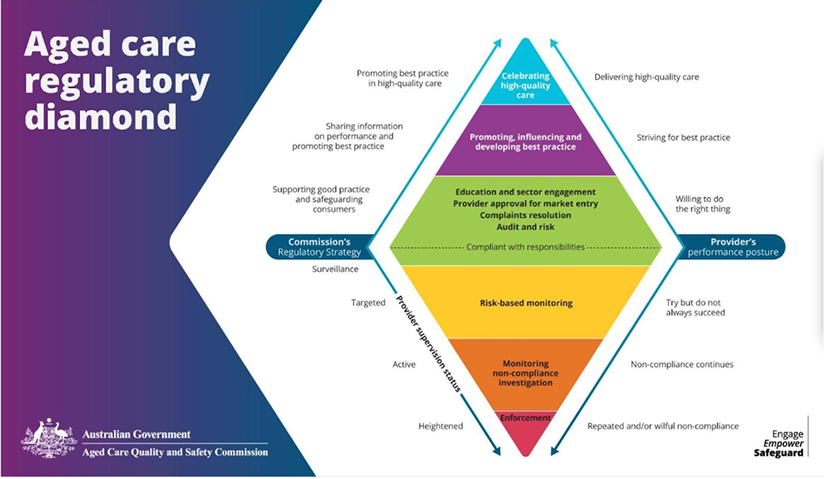Posted on Monday, 24th November, 2025
Unilever Food Solutions attended the 2025 Aged Care Catering Summit in Brisbane to find out the latest trends and topics affecting aged care foodservice in the near future.
The Summit covered the following key topics in a series of keynote and panel discussions with industry experts:
-The upcoming Aged Care Quality Standards
- Nutrition and wellbeing for frail residents
- Smart menu design
- Allergensith
Aged Care Quality Standards
The Aged Care Quality and Safety Commissioner, Liz Hefren-Webb, presented the keynote Rewriting the Recipe - Aged Care Catering Under Reform.
Liz outlined what the strengthened Aged Care Quality Standards, effective from 1st November 2025, mean for aged care catering, what the key changes are and what priorities aged care providers can focus on in the short term in regard to Standard 6: Food and Nutrition.
Key Changes:
Liz says the standards bring in a new level of compliance, which includes increased scrutiny. Providers will be audited every three years starting in November. She pointed out it will take time to roll out these audits across all the providers.

The Aged Care Quality and Safety Commissioner, Liz Hefren-Webb, presented the keynote Rewriting the Recipe - Aged Care Catering Under Reform.
Liz outlined what the strengthened Aged Care Quality Standards, effective from 1st November 2025, mean for aged care catering, what the key changes are and what priorities aged care providers can focus on in the short term in regard to Standard 6: Food and Nutrition.
Key Changes:
Liz says the standards bring in a new level of compliance, which includes increased scrutiny. Providers will be audited every three years starting in November. She pointed out it will take time to roll out these audits across all the providers.
What the new Aged Care Quality Standards implementation looks
like in practical terms.

Liz explained the expectations of the Commission, which is to see providers who are actively working in good faith to meet the standards and who have documented proof of how they are doing this.
She went on to offer the following priorities as the initial focus for providers who are unsure what they need to be doing from 1st November:
- Ensure residents at your home have the ability to engage with and make informed choices about their care, food and nutrition. It is about the person having control over what they eat, when they eat it and how they eat it
- Clear, easy-to-use ways for people to give feedback and communicate with the catering staff, with processes that document the feedback
- Buy-in at the leadership and governance level - while this is not something chefs and catering staff can directly implement, they are able to influence via management what is happening in the dining space to effect any changes needed, so they are able to meet Standard 6: Food and Nutrition

Improving nutrition and wellbeing of frail residents.
One of the missed meal opportunities raised by the discussion was about having supper as an option for residents. It was noted that the evening meal is typically served early, around 5 to 6 pm, and residents don’t often have another opportunity to eat until breakfast the next day.
Introducing a late evening meal - much like a mid-meal, such as morning or afternoon tea, with both savoury and sweet options can add a significant amount of food intake for the day and boost wellbeing.
Smart menu design
Rodger Graf from Nutritious Cuisine talked about how smart menu design can help providers meet Standard 6: Food and Nutrition by not only making sure there is ‘something for everyone’, but a range of choices for everyone at each mealtime, including mid-meals. He mentioned he is in contact with providers who are trialling ‘all-day grazing menus’ where everything on the menu is available at any time of day, giving people more choice about what they eat and when they eat it. This helps to alleviate the problem of residents who may not wish to eat specific meals at a specific time and subsequently miss out on meals due to food not being available outside set mealtimes.
Allergens
In step with the New Aged Care Quality Standards, were discussions about allergens; a growing area of focus for aged care kitchens. Statistics show an increase in food intolerances and allergies in people entering aged care homes. Experts Julie Chichero (IDDSI), Ingrid Roche (Allergy expert), Sandra Grey-Smith (dementia), Julie Dundon (dietitian) and Dijana Dragicevich (speech pathologist) headlined the various discussions.
Importantly for the relationship between Standard 6: Food and Nutrition and Standard 1: Consumer Dignity and Choice, clear communication about the risks is essential. What was emphasised is that ultimately it is the residents’ choice to eat the food they want to eat. Where there is risk, it must be clearly communicated, and if the choice is to eat food that poses a risk, support is provided.
For example, if a resident wishes to eat a meal which is not at the recommended texture level, a suitably qualified care person is able to assist to make the experience as safe as possible. This would then be documented and filed as part of the new standards.
Kitchen efficiency
Other discussion points centred around kitchen equipment and efficiency, as well as the ongoing need for training for all aspects of food in aged care, including equipment training, dining experience and aged care food skills.

FAQs:
1. What are the key compliance changes from 1 November 2025?
The strengthened standards introduce a new level of compliance and increased scrutiny, with providers audited every three years from November 2025 and a staged rollout across providers. Initially, the Commission expects good-faith efforts backed by documented evidence.
2. If we’re unsure what to do first for Standard 6, where should we focus?
Prioritise resident choice and control over food and mealtimes; set up clear, easy feedback channels with documentation; and ensure leadership/governance buy-in so dining practices can change to meet Standard 6.
3. How can we improve intake and uphold consumer dignity alongside Standard 6?
Add a late-evening “supper” to close the long overnight gap; design menus with multiple choices at every eating occasion, and manage allergen risks through clear communication, resident choice, qualified support when risks are accepted, and thorough documentation.
Find out more about Aged Care RE:FRESH

Disclaimer: The content of this article is created for inspiration purposes only. It is not intended as clinical, medical or nutritional advice.
Resources
Standard 5 Fact Sheet
Standard 5 Video
Strengthened Aged Care Quality Standards - February 2025
Online education Anchor Excellence Academy The Sprint: Strengthened Aged Care Quality Standards for Residential Aged Care
Standard 6 is also impacted by Standard 3 - Care and Service.
Log in or Create an account to access:
- Get access to this content
- Discover the latest culinary trends
- Explore and save your favourite recipes
- Watch free video training courses for chefs
